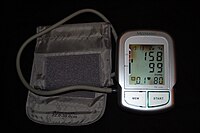
Photo from wikipedia
The diagnosis of posterior reversible encephalopathy syndrome (PRES) is both commonly made and not considered. Far before the introduction of the moniker PRES, clinicians and pathologists linked hypertension to damage… Click to show full abstract
The diagnosis of posterior reversible encephalopathy syndrome (PRES) is both commonly made and not considered. Far before the introduction of the moniker PRES, clinicians and pathologists linked hypertension to damage of the brain, particularly when blood pressure was out of control. White matter abnormalities were seen earlier in eclampsia and particularly with cyclosporine-induced leukoencephalopathy [1, 2], raising the possibility that immunomodulation was involved in the pathogenesis. As early as 1988, reports surfaced on reversible cortical and white matter lesions on magnetic resonance imaging (MRI) acquisitions [3], but a report on white matter brain edema on a computed tomography (CT) scan in severe hypertension was already known in 1980 [4]. There is an interesting history of severe hypertensive encephalopathy, a condition seen regularly in intensive care units.
Journal Title: Neurocritical Care
Year Published: 2022
Link to full text (if available)
Share on Social Media: Sign Up to like & get
recommendations!